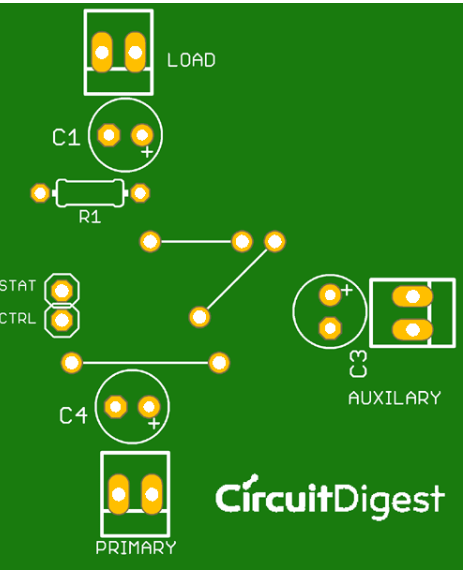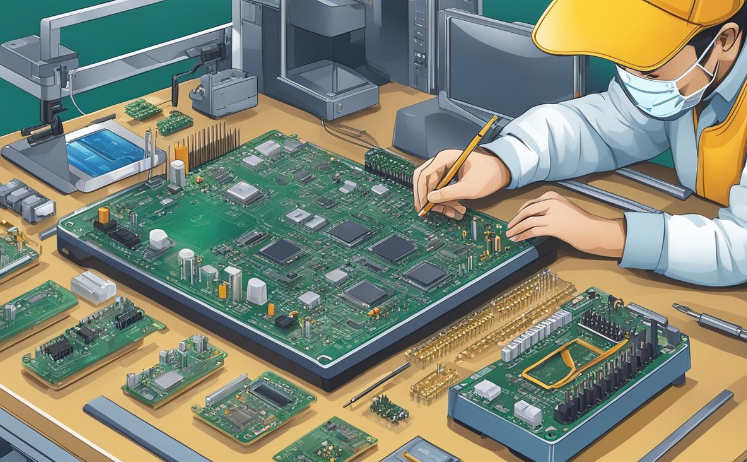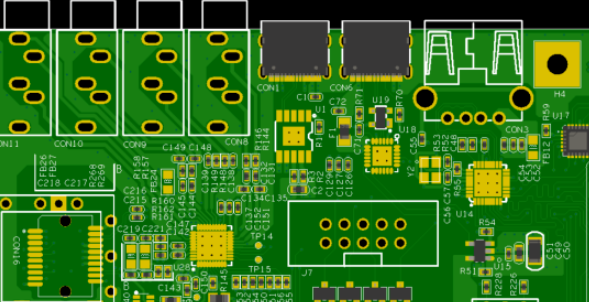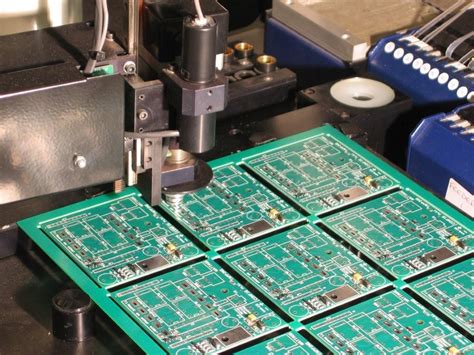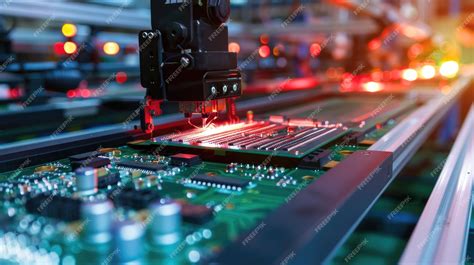Automated pcb assembly machines
Benefits Of Automated PCB Assembly Machines
Automated PCB assembly machines have revolutionized the electronics manufacturing industry, offering a myriad of benefits that enhance efficiency, precision, and overall production quality. One of the most significant advantages of these machines is their ability to drastically reduce human error.
In traditional manual assembly, even the most skilled technicians are prone to occasional mistakes, which can lead to defective products and increased costs.
Automated systems, however, operate with a high degree of accuracy, ensuring that each component is placed precisely where it needs to be. This precision not only minimizes errors but also enhances the reliability and performance of the final product.
Moreover, the speed at which automated PCB assembly machines operate is unparalleled. These machines can work continuously without fatigue, unlike human workers who require breaks and are subject to varying levels of productivity. As a result, production lines equipped with automated assembly machines can achieve significantly higher throughput, meeting tight deadlines and accommodating large-scale orders with ease. This increased efficiency translates to faster time-to-market for new products, giving companies a competitive edge in the fast-paced electronics industry.
In addition to speed and accuracy, automated PCB assembly machines offer remarkable consistency.
Each unit produced is virtually identical to the last, ensuring uniformity across large batches. This consistency is crucial for maintaining quality standards and meeting regulatory requirements. Furthermore, automated systems can easily adapt to different product designs and specifications. With programmable settings, these machines can switch between different assembly tasks with minimal downtime, making them highly versatile and suitable for a wide range of applications.
Another notable benefit is the cost-effectiveness of automated PCB assembly.
While the initial investment in these machines can be substantial, the long-term savings are considerable. Reduced labor costs, lower error rates, and increased production speeds all contribute to a more cost-efficient manufacturing process.
Additionally, automated systems often require less rework and fewer repairs, further reducing operational expenses. Over time, the return on investment for automated PCB assembly machines can be quite significant, making them a wise choice for companies looking to optimize their production processes.
Environmental considerations also play a role in the appeal of automated PCB assembly machines. These systems are designed to be energy-efficient and often produce less waste compared to manual assembly methods.
By optimizing the use of materials and reducing the likelihood of defective units, automated machines contribute to more sustainable manufacturing practices. This not only benefits the environment but also aligns with the growing consumer demand for eco-friendly products and practices.
Furthermore, the integration of advanced technologies such as artificial intelligence and machine learning into automated PCB assembly machines has opened new avenues for innovation. These technologies enable predictive maintenance, real-time monitoring, and adaptive learning, allowing machines to optimize their performance continuously. This leads to even greater efficiency and reliability, as well as the ability to quickly identify and address potential issues before they escalate.
In conclusion, the benefits of automated PCB assembly machines are manifold, encompassing improved accuracy, speed, consistency, cost-effectiveness, and environmental sustainability.
As technology continues to advance, these machines are likely to become even more sophisticated, further enhancing their capabilities and solidifying their role as indispensable tools in the electronics manufacturing industry. Companies that invest in automated PCB assembly machines are well-positioned to reap the rewards of increased productivity, higher quality products, and a stronger competitive position in the market.
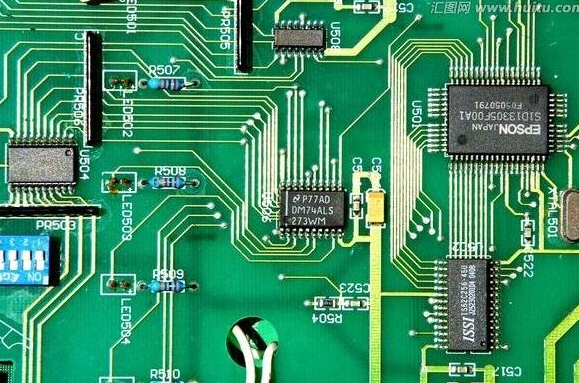
How Automated PCB Assembly Machines Improve Efficiency
Automated PCB assembly machines have revolutionized the electronics manufacturing industry, significantly enhancing efficiency and productivity.
These machines, which include pick-and-place devices, soldering robots, and automated optical inspection systems, streamline the production process by reducing human error and increasing throughput. As a result, companies can produce high-quality printed circuit boards (PCBs) at a faster rate and lower cost, ultimately benefiting both manufacturers and consumers.
One of the primary ways automated PCB assembly machines improve efficiency is by minimizing the time required for component placement.
Traditional manual assembly methods are labor-intensive and prone to errors, as human operators must meticulously place each component onto the PCB. In contrast, automated pick-and-place machines can accurately position thousands of components per hour, significantly speeding up the assembly process. These machines use advanced vision systems and precision robotics to ensure that each component is placed correctly, reducing the likelihood of defects and rework.
Moreover, automated soldering machines further enhance efficiency by providing consistent and reliable solder joints.
Manual soldering can be inconsistent, as it depends on the skill and experience of the operator. Automated soldering machines, such as reflow ovens and wave soldering systems, ensure that each joint is formed under optimal conditions, resulting in higher-quality connections.
This consistency not only improves the overall reliability of the PCB but also reduces the need for costly and time-consuming rework.
In addition to improving the speed and quality of assembly, automated PCB assembly machines also contribute to better inventory management.
These machines can be integrated with enterprise resource planning (ERP) systems, allowing manufacturers to track component usage in real-time. This integration helps prevent stockouts and overstock situations, ensuring that the right components are always available when needed. Consequently, manufacturers can maintain a lean inventory, reducing carrying costs and minimizing waste.
Furthermore, automated optical inspection (AOI) systems play a crucial role in enhancing efficiency by identifying defects early in the production process. AOI systems use high-resolution cameras and sophisticated algorithms to inspect PCBs for various defects, such as misaligned components, solder bridges, and missing parts. By detecting these issues early, manufacturers can address them before the PCBs move to the next stage of production, reducing the likelihood of costly rework and scrap. This early detection also helps maintain a high level of quality, ensuring that only defect-free products reach the end customer.
Another significant advantage of automated PCB assembly machines is their ability to handle complex and high-density designs.
As electronic devices become more compact and feature-rich, the demand for intricate PCB layouts has increased. Automated machines can easily manage these complex designs, placing tiny components with high precision and accuracy. This capability allows manufacturers to produce cutting-edge products that meet the ever-evolving demands of the market.
In conclusion, automated PCB assembly machines have become indispensable in the electronics manufacturing industry, offering numerous benefits that enhance efficiency.
By reducing the time required for component placement, ensuring consistent solder joints, improving inventory management, and enabling early defect detection, these machines help manufacturers produce high-quality PCBs at a lower cost.
Additionally, their ability to handle complex designs ensures that companies can keep pace with technological advancements and deliver innovative products to consumers. As the industry continues to evolve, the adoption of automated PCB assembly machines will undoubtedly play a critical role in driving further improvements in efficiency and productivity.
Key Features To Look For In Automated PCB Assembly Machines
When considering the acquisition of automated PCB assembly machines, it is crucial to understand the key features that can significantly impact the efficiency, accuracy, and overall performance of your production line.
These machines, integral to modern electronics manufacturing, offer a range of functionalities that can streamline operations and enhance product quality. Therefore, identifying the essential attributes of these machines is paramount for making an informed investment.
First and foremost, precision and accuracy are fundamental characteristics to evaluate.
Automated PCB assembly machines must be capable of placing components with high precision to ensure the functionality and reliability of the final product. Advanced vision systems and alignment technologies are often employed to achieve this level of accuracy. These systems use cameras and sensors to detect the exact position of components and PCBs, making real-time adjustments to correct any misalignments. Consequently, this reduces the likelihood of errors and rework, thereby increasing overall production efficiency.
In addition to precision, the speed of the assembly process is another critical factor.
High-speed placement capabilities can significantly boost production throughput, allowing manufacturers to meet tight deadlines and high-volume demands. However, it is essential to balance speed with accuracy, as overly rapid operations may compromise the quality of the assembly. Therefore, machines that offer adjustable speed settings and maintain consistent performance at various speeds are highly desirable.
Another key feature to consider is the versatility of the machine. The ability to handle a wide range of component types and sizes is invaluable, especially in an industry where product designs frequently evolve.
Machines equipped with multiple feeders and interchangeable nozzles can accommodate different components, from tiny surface-mount devices to larger through-hole components. This flexibility not only enhances the machine’s utility but also future-proofs the investment against changing manufacturing requirements.
Moreover, ease of programming and operation is a significant consideration.
User-friendly software interfaces and intuitive controls can greatly reduce the learning curve for operators, minimizing downtime and training costs.
Advanced machines often come with software that supports offline programming, allowing engineers to prepare assembly programs without halting production. Additionally, features such as automatic calibration and self-diagnostics can further simplify operation and maintenance, ensuring that the machine remains in optimal working condition.
Furthermore, the integration capabilities of automated PCB assembly machines should not be overlooked.
Seamless integration with other equipment and systems within the production line, such as solder paste printers, reflow ovens, and inspection systems, can create a cohesive and efficient manufacturing environment.
Machines that support standard communication protocols and offer robust connectivity options facilitate this integration, enabling real-time data exchange and coordinated operations.
Lastly, the reliability and durability of the machine are paramount. Investing in a machine that is built to withstand the rigors of continuous operation can prevent costly downtime and maintenance issues.
Reputable manufacturers often provide detailed specifications on the expected lifespan and maintenance requirements of their machines, along with comprehensive warranties and support services. Evaluating these aspects can provide peace of mind and ensure a long-term return on investment.
In conclusion, when selecting automated PCB assembly machines, it is essential to consider features such as precision, speed, versatility, ease of operation, integration capabilities, and reliability. By carefully evaluating these attributes, manufacturers can choose a machine that not only meets their current production needs but also adapts to future challenges, ultimately enhancing the efficiency and quality of their manufacturing processes.

The Future Of Automated PCB Assembly Technology
The future of automated PCB assembly technology is poised to revolutionize the electronics manufacturing industry, bringing unprecedented levels of efficiency, precision, and scalability.
As the demand for smaller, more complex electronic devices continues to grow, the need for advanced assembly solutions becomes increasingly critical.
Automated PCB assembly machines, equipped with cutting-edge technologies, are at the forefront of this transformation, promising to reshape the landscape of electronics production.
One of the most significant advancements in automated PCB assembly technology is the integration of artificial intelligence and machine learning.
These technologies enable machines to learn from data, optimize processes, and make real-time adjustments, resulting in higher accuracy and reduced error rates. For instance, AI-driven inspection systems can identify defects and anomalies with greater precision than human inspectors, ensuring that only high-quality products move forward in the production line. This not only enhances product reliability but also minimizes waste and reduces costs.
Moreover, the advent of Industry 4.0 has brought about a new era of connectivity and data exchange in manufacturing.
Automated PCB assembly machines are now equipped with IoT (Internet of Things) capabilities, allowing them to communicate with other machines and systems seamlessly. This interconnectedness facilitates better coordination and synchronization across the production floor, leading to more efficient workflows and shorter lead times. Additionally, real-time data analytics provide valuable insights into machine performance and production metrics, enabling manufacturers to make informed decisions and implement continuous improvements.
Another key development in automated PCB assembly technology is the use of advanced robotics.
Modern assembly machines are equipped with high-precision robotic arms that can handle delicate components with exceptional accuracy. These robots are capable of performing complex tasks such as soldering, component placement, and inspection with remarkable speed and consistency.
The use of robotics not only enhances the quality of the final product but also reduces the reliance on manual labor, addressing the challenges of labor shortages and rising labor costs.
Furthermore, the trend towards miniaturization in electronics has driven the need for more sophisticated assembly techniques. Automated PCB assembly machines are now capable of handling ultra-fine pitch components and micro-sized parts that are beyond the capabilities of traditional assembly methods.
This capability is crucial for the production of modern electronic devices, such as smartphones, wearables, and IoT gadgets, which require compact and densely packed PCBs.
By leveraging advanced placement technologies, manufacturers can achieve higher component densities and more complex designs, pushing the boundaries of what is possible in electronics manufacturing.
In addition to technological advancements, the future of automated PCB assembly technology is also shaped by sustainability considerations. As environmental concerns become more prominent, manufacturers are increasingly adopting eco-friendly practices and materials. Automated assembly machines are designed to minimize energy consumption and reduce waste, contributing to a more sustainable manufacturing process.
For example, precision soldering techniques reduce the amount of solder used, while efficient material handling systems minimize scrap and rework. These efforts not only benefit the environment but also enhance the overall efficiency and cost-effectiveness of the production process.
In conclusion, the future of automated PCB assembly technology is characterized by the integration of AI, IoT, advanced robotics, and sustainable practices. These innovations are driving significant improvements in efficiency, precision, and scalability, enabling manufacturers to meet the growing demand for complex and miniaturized electronic devices. As the industry continues to evolve, automated PCB assembly machines will play a pivotal role in shaping the future of electronics manufacturing, delivering high-quality products with greater speed and reliability.

Cost-Effectiveness Of Automated PCB Assembly Machines
Automated PCB assembly machines have revolutionized the electronics manufacturing industry, offering a myriad of benefits that extend beyond mere efficiency. One of the most compelling advantages of these machines is their cost-effectiveness, which has become a significant factor for companies aiming to stay competitive in a rapidly evolving market. By delving into the various aspects of cost-effectiveness, it becomes evident how automated PCB assembly machines can lead to substantial financial savings and operational improvements.
To begin with, automated PCB assembly machines significantly reduce labor costs. Traditional PCB assembly is labor-intensive, requiring skilled workers to manually place and solder components onto the boards.
This process is not only time-consuming but also prone to human error, which can lead to costly rework and quality control issues.
In contrast, automated machines can operate continuously with minimal human intervention, drastically cutting down on labor expenses. Moreover, the precision and consistency of automated systems ensure higher quality output, reducing the likelihood of defects and the associated costs of rectifying them.
In addition to labor savings, automated PCB assembly machines contribute to cost-effectiveness through increased production speed. These machines are capable of assembling PCBs at a much faster rate than human workers, enabling manufacturers to meet high-volume demands without compromising on quality.
The ability to produce more units in a shorter time frame translates to higher throughput and, consequently, greater revenue potential.
Furthermore, the scalability of automated systems allows companies to easily ramp up production in response to market demands, providing a flexible and efficient solution for managing fluctuating order volumes.
Another critical factor in the cost-effectiveness of automated PCB assembly machines is the reduction in material waste. Manual assembly processes often result in significant material wastage due to inaccuracies and handling errors. Automated machines, on the other hand, are designed to optimize material usage, ensuring precise placement and soldering of components.
This not only minimizes waste but also reduces the cost of raw materials, contributing to overall savings. Additionally, the advanced software and sensors integrated into these machines enable real-time monitoring and adjustments, further enhancing material efficiency and reducing the likelihood of costly errors.
Energy efficiency is another area where automated PCB assembly machines offer cost benefits.
Modern machines are designed with energy-saving features that reduce power consumption without compromising performance. This is particularly important in an era where energy costs are rising and environmental sustainability is a growing concern. By lowering energy usage, companies can achieve significant cost savings while also reducing their carbon footprint, aligning with broader corporate social responsibility goals.
Moreover, the long-term financial benefits of investing in automated PCB assembly machines cannot be overlooked.
While the initial capital expenditure for these machines may be substantial, the return on investment (ROI) is typically realized within a relatively short period due to the cumulative savings in labor, materials, and energy costs. Additionally, the durability and reliability of automated systems mean lower maintenance and repair costs over time, further enhancing their cost-effectiveness.
In conclusion, the cost-effectiveness of automated PCB assembly machines is multifaceted, encompassing labor savings, increased production speed, reduced material waste, energy efficiency, and long-term financial benefits. As the electronics manufacturing industry continues to evolve, the adoption of automated systems is not merely a trend but a strategic imperative for companies seeking to optimize their operations and maintain a competitive edge. By embracing automation, manufacturers can achieve significant cost savings while also enhancing the quality and efficiency of their production processes.


